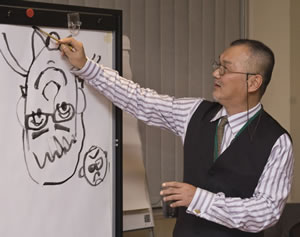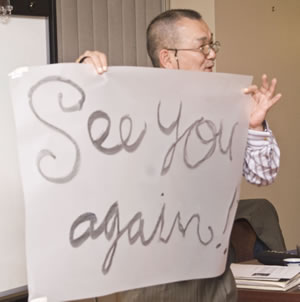On Friday, 18 February the Embassy of Japan welcomed the famous Japanese manga artist Seiji Iwami to give a masterclass in his art. He was visiting the UK as a Japanese Cultural Envoy. That evening he attended a reception at the Embassy, at which the results of the Manga Jiman Competition 2011 were announced and the prizes awarded.
Before the masterclass, we interviewed Mr Iwami, whose warmth and humour were infectious throughout. We started by asking him why he had become involved in manga, to which the reply was very simple: "Because I like it!" His passion for manga had started before he was five years old, and from an early age he resolved to become a manga artist. |
|
On the subject of whether Mr Iwami had found any inspiration for his work during his visit to the UK, he admitted to having been overwhelmed by what he had seen. He had just been to Edinburgh and Oxford, where everything was fascinatingly different from what he was used to. When looking round Oxford's medieval buildings, he wanted to examine each gargoyle! There was almost too much to engage his senses.
Mr Iwami was impressed by the quality of the Manga Jiman Competition contestants. However, he felt that, if anything, they were trying too hard to replicate the Japanese essence of manga. The UK had a wealth of theatrical tradition and he wanted to see these young Britons reflect this heritage in their work. "After all, when you eat sushi abroad, it's always a little different. And haggis made by a Japanese may not taste quite like the real thing!" He urged the contestants to impose their own personalities and identities on their work.
As for the ingredients for success as a manga artist, Mr Iwami emphasised that it is ultimately a form of entertainment. Thus, if one is to transcend the amateur level as an artist, one has to consider one's audience. Just as a novel differs from a diary regarding whom it is written for, a manga artist must keep in mind his or her role as an entertainer.
|

|
Commenting on the reasons for the appeal of manga overseas, Mr Iwami's answer was: "Because it's interesting!" Tasty food is tasty, no matter where you come from. Les Miserables has been a stage hit all over the world. Manga has a universal appeal. Similarly, when asked if manga could play a role in promoting mutual understanding between Japan and other countries, he emphasised that, like delicious food and music, it transcends barriers of language and can create happiness in the process. He pointed out that The Beatles' music is enjoyed all over the world, even where people do not understand the words to the songs.
Mr Iwami's masterclass was attended by 23 budding artists, all of whom had some experience in manga. He introduced himself by writing his name in hiragana and then using the symbols as a basis on which to sketch a picture of himself - complete with a cheeky cat peeping out from behind. He then passed around an album of his works.
|
He emphasised the importance of having a clear story or idea in mind before commencing the artwork. An artist's work was more likely to be published if it had a happy theme, or at least a story that ended on an uplifting note.
The participants' task, for which they were given 15 minutes, was to complete a 4-koma (four-frame) manga, one in which the story is completed in four frames or panels, with the first and fourth frames having been provided by Mr Iwami. He explained that the four key steps, one for each frame, comprised the first scene in which something happens, the second scene in which the story continues, the critical third scene in which there is a twist or something that takes the reader by surprise, and the fourth and final scene, in which the story concludes. He likened the manga artist's mission to that of a mystery writer, who intrigues and misleads the reader with skilfully-placed clues before bringing the story to its dramatic conclusion.
|
 |
In a lively atmosphere, Mr Iwami willingly answered a number of questions on such subjects as how he gets the ideas for his creations as well as on technical issues like the use of perspective. To everyone's amusement, he drew a manga-style sketch of two of the participants - the second upside down! Finally, he puzzled the participants with a seemingly abstract effort - until the paper was turned upside down and back to front to reveal, in English, his parting message: "See you again!" |
An example of Mr Iwami's work:
|


